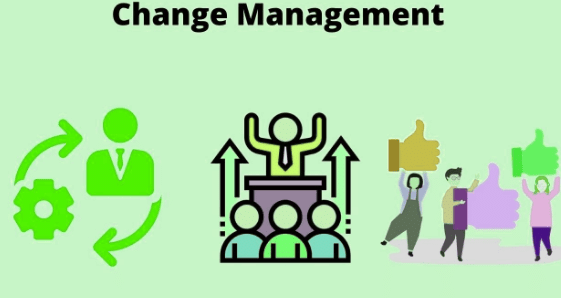Organizational Development & Organizational Change | Crash Course for UGC NET Commerce PDF Download
Change Management: Definition and Significance

Change Management is a structured approach that assists organizations in transitioning from their current state to a desired future state. It involves effectively managing change at both individual and corporate levels. The process addresses the potential gap between what a company aims to achieve over time and what it has accomplished. By navigating this gap, change management helps organizations adjust their processes or operations to achieve their desired outcomes.
Various factors influence organizational culture, which in turn can lead to changes within the organization.
Importance of Change Management:
The significance of change management can be summarized in several key points:
Understanding the Need for Change: Just as seasons change, businesses must adapt to new trends, technologies, or market conditions. This adaptation is essential not only for survival but also for growth and improvement.
Managing Resistance: People naturally resist change because it disrupts their comfort zones. Change management helps address this resistance, making transitions smoother.
Advantages of Change Management:
The benefits of change management include:
Smooth Transition: Change management acts like a GPS, guiding organizations smoothly from old ways of doing things to new ones. Without it, the transition can be chaotic and confusing.
Sustaining Change: Change management ensures that new processes or behaviors become ingrained as standard practices rather than temporary measures.
Objectives of Change Management:
The objectives of change management are:
Effective Communication: One of the primary goals is to clearly communicate the necessity of change and its long-term benefits for everyone involved.
Supporting Individuals: Change can be intimidating. Another objective is to provide the necessary support and training to help individuals adapt.
Features of Change Management:
Key features of change management include:
Structured Approach: Change management is not about improvisation. It involves a structured approach to transitioning individuals, teams, and organizations from a current state to a desired future state.
Inclusive Process: Change management is not just a top-down process. Successful change management involves everyone in the organization, ensuring that all voices are heard.
Different types of organizational culture require different approaches to change management. Understanding the organizational culture is crucial for effective change management.
Causes of Change
 Change is an inevitable part of life, constantly shaping the world around us. Various factors can trigger change, ranging from individual actions to broader societal forces. Here are some key factors that contribute to change:
Change is an inevitable part of life, constantly shaping the world around us. Various factors can trigger change, ranging from individual actions to broader societal forces. Here are some key factors that contribute to change:
Recognition of Need or Desire: Change often begins with recognizing the need or desire for something different, driven by personal growth, a quest for improvement, or a yearning for new experiences.
External Events and Circumstances: External events, such as political shifts, technological advancements, or natural disasters, can disrupt established norms, prompting people to adapt and reshape their lives.
Social and Cultural Changes: Shifts in values, beliefs, and attitudes can influence societal norms and expectations, leading to advocacy, activism, and movements for social justice that challenge existing structures.
Economic Factors: Changes in the job market, economic growth or decline, and technological advancements impact industries and individuals, requiring adaptation to remain competitive.
Environmental Factors: Environmental changes, such as climate change, natural disasters, or resource scarcity, can have profound effects on ecosystems, communities, and economies. This drives the need for sustainable practices and environmental stewardship.
Change is driven by a complex interplay of internal motivations, external circumstances, and interactions between individuals and society. Embracing and adapting to change is essential for personal growth, societal progress, and navigating an ever-evolving world. Understanding organizational culture is key to comprehending the causes of change.
Organizational Development: Definition
Organizational Development (OD) is a systematic, planned effort aimed at improving the overall health and effectiveness of an organization. It involves implementing processes, interventions, and strategies to enhance organizational capabilities, foster a positive culture, and promote sustainable change. OD is typically facilitated by internal or external consultants who collaborate with leadership and employees to design and execute change initiatives. The primary goal is to create a more adaptive, effective, and thriving organization in a dynamic and competitive environment.
Organizational Development and Organizational Change
- Explaining organizational change and development can be likened to a transformative journey for a company—much like a caterpillar turning into a butterfly.
- In business, this transformation often involves shifts in strategy, procedures, technology, or culture.
- At the core of corporate change is how companies manage these transitions.
- It’s about realizing that the current way of doing things may not be ideal for future growth.
- Whether the change is driven by market shifts, technological advancements, or the desire to improve corporate culture, organizational change guides businesses from their current state to their envisioned future.
- Similar to planning a journey, organizational change requires identifying a clear destination and mapping out the best path to get there.
- This involves understanding the organization’s present condition, defining the desired state, and developing a roadmap to bridge the gap between the two.
- Organizational development plays a crucial role in this process.
- It’s like the vehicle that transports the company toward its goals.
- OD is a strategic initiative focused on enhancing a company’s effectiveness and ensuring long-term viability.
- Recruitment, selection, training, and development are vital tools for managing organizational change and development.
Importance of Organizational Change and Development
The significance of organizational change and development can be summarized as follows:
- Adapting to Market Changes: Similar to a surfer adjusting to the movements of a wave, businesses must adapt to market changes to stay competitive. Organizational change enables them to do so.
- Embracing Innovation: Just like upgrading from a flip phone to a smartphone, businesses need to embrace technological innovations to keep up with competitors and meet customer expectations. Organizational change facilitates this process.
- Improving Efficiency: Much like changing how you clean your house to make it quicker and more effective, organizational change helps businesses find and implement more efficient ways of working.
- Attracting and Retaining Talent: A workplace that never evolves can be dull and unappealing. Companies that embrace change and development are more likely to attract and retain talented employees who seek dynamic, forward-thinking environments.
- Staying Competitive: In a race, you need to run fast to stay ahead. Likewise, businesses need to stay ahead of competitors, and organizational change and development provide that competitive advantage.
- Boosting Growth: Similar to how a plant requires the right conditions to grow, businesses must adapt and develop to achieve growth and expansion.
- Increasing Profits: When a company adapts to market changes, improves efficiency, attracts top talent, stays competitive, and drives growth, it stands a good chance of boosting its profitability.
Conclusion
Understanding concepts like change management and organizational development equips future leaders with the tools needed to succeed in a rapidly changing world. Organizational change and development are about more than just surviving; they are about creating an environment where businesses can thrive, innovate, and lead in their industry.
|
157 videos|236 docs|166 tests
|
FAQs on Organizational Development & Organizational Change - Crash Course for UGC NET Commerce
| 1. What are the factors that can affect organizational culture and change? |  |
| 2. How can organizations ensure a smooth transition during a period of change? |  |
| 3. What are the objectives of change management in an organization? |  |
| 4. What are some common causes of change in a firm? |  |
| 5. How can organizations make sure that changes implemented stick in the long term? |  |





















